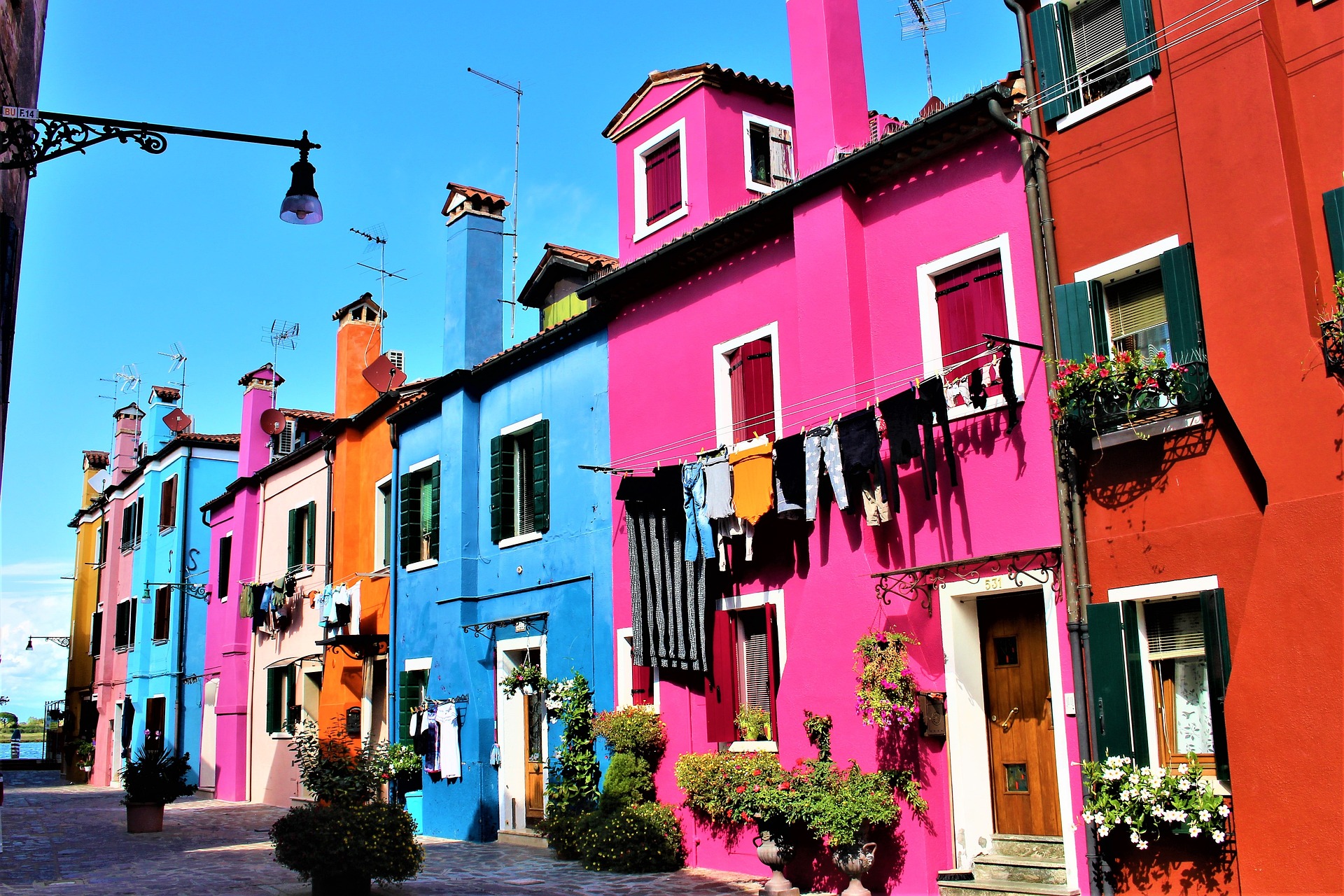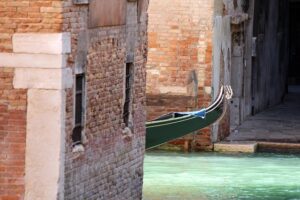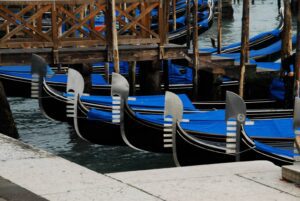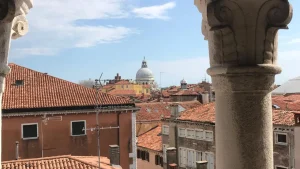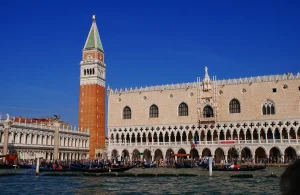The Venetian Lagoon — Nature, Islands & Quiet Corners Beyond Venice
Venice doesn’t float on the sea by magic — she lives inside the Venetian Lagoon, a shallow, shimmering world of canals, salt marshes, and islands. Here, fishermen still mend nets, farmers harvest artichokes, monks pray in cypress gardens, and brightly painted houses glow at sunset. This guide introduces the lagoon’s unique ecosystem and the islands you’ll love most: Burano, Mazzorbo & Venissa, Torcello, Sant’Erasmo, San Francesco del Deserto, Vignole, and Lido di Venezia.
🗺️ What (and Where) Is the Venetian Lagoon?
The Venetian Lagoon is a shallow, sheltered bay in the northern Adriatic Sea, fringed by barrier islands that separate it from the open water. It stretches roughly 50 km north–south, with an average depth around 1.5 m (5 ft) outside the dredged navigation channels. That shallowness makes it extraordinarily alive — and equally sensitive to change.
- Barene (salt marshes): green sponges that protect shores, filter water, and nurture young fish.
- Canali & ghebi: tide-cut channels and tiny creeks threading the marsh.
- Islands: urban Venice, artisan Murano, colorful Burano, ancient Torcello, agricultural Sant’Erasmo, monastic retreats, and sandy Lido.
Three inlets exchange lagoon and sea water with every tide, renewing the system twice daily and setting the slow heartbeat of life here.
🪸 A Fragile, Flourishing Ecosystem
The lagoon shelters herons, egrets, terns, cormorants, seasonal migrants, eelgrass meadows, and salt-loving plants that anchor the mudflats. Traditional activities — small-scale fishing, farming, boatbuilding — evolved in balance with tides. Today, that balance needs care.
Current Challenges
- Pollution & erosion: legacy contaminants and boat wakes that wear away marsh edges.
- Sea-level rise & storms: more frequent surges and acqua alta stress both nature and heritage.
- Subsidence: gradual land lowering makes low-lying areas more vulnerable.
Restoration projects rebuild salt marshes and monitor tides; as visitors, we help by traveling light on the water, respecting no-wake zones, and supporting island communities.
🚤 How to Visit the Lagoon (Routes, Boats, Timing)
- Public boats: From Fondamente Nove, Line 12 serves Murano → Mazzorbo → Burano → Torcello. From San Zaccaria, Line 14 runs to Lido.
- Private boats: Best for quiet canals, flexible timing, and connecting multiple islands in one day.
- Best times: Early morning (calm, luminous) and late afternoon into sunset (golden hour). Midday is the busiest.
- Bring: Layers (breeze on open water), sun protection, reusable bottle, and comfortable shoes.
🎨 Burano — Color, Canals & Lace
Burano is a joy: canals lined with houses painted raspberry, pistachio, lemon, and sky-blue. The story goes that fishermen painted bold colors to spot home through mist. Today the palette maps community pride.
Highlights
- Lace tradition: Visit the Lace Museum and tiny ateliers to watch needle lace made by hand.
- Canal strolls: Cross low bridges for postcard views; don’t miss the leaning campanile.
- Seafood lunch: Try risotto de gò (goby), grilled cuttlefish, or lagoon eel in season.
Burano is perfect for photographers and flâneurs — then amble across the wooden bridge to quieter Mazzorbo.
🍇 Mazzorbo — Gardens, Dorona Vines & Slow Living
Linked to Burano by a footbridge, Mazzorbo is green and gentle: orchards, kitchen gardens, and the historic Dorona grape revived in island vineyards. It’s the agricultural soul of this corner of the lagoon.
What to See
- Santa Caterina: A calm 14th-century church with a slender bell tower.
- Dorona tasting: Sample the saline-kissed white wine that tastes of sun and sea breeze.
- Paths & canals: Peaceful walks with Burano’s colors glowing across the water.
🌿 Venissa Wine Estate
On Mazzorbo sits Venissa: vineyards, gardens, and a refined table celebrating lagoon produce and Dorona wines. Book for a long, elegant lunch or a glass at golden hour — it’s the essence of slow lagoon life.
⛪ Torcello — Venice’s Ancient Heart
Torcello was a major lagoon center before Rialto rose — a refuge for mainlanders in the early Middle Ages. Today it’s a quiet island of reeds, canals, and profound history.
Don’t Miss
- Cathedral of Santa Maria Assunta: 7th-century roots, solemn Byzantine mosaics (the Last Judgment is unforgettable).
- Church of Santa Fosca: Harmonious geometry and intimate light.
- Bell-tower view: Marsh, water, sky — the lagoon laid out like a map.
Legend lovers: look for “Attila’s Throne” (medieval, not actually Hun-related) in the grassy square.
🥬 Sant’Erasmo — The Vegetable Garden of Venice
If Venice eats well, thank Sant’Erasmo. Fields here grow artichokes (the prized spring castraure), asparagus, tomatoes, and salad greens that supply city markets.
Good to Do
- Farm stands: Buy whatever’s in season; it will be delicious.
- Easy cycling: Flat roads, sea breezes, and long horizons — rent a bike and roam.
- Quiet beaches: Simple sandy spots for a dip and a book.
The 17th-century Church of San Erasmo offers a cool, contemplative pause between rides.
🕊️ San Francesco del Deserto — Monks, Cypress & Silence
Between Burano and Sant’Erasmo, the island monastery of San Francesco del Deserto keeps a centuries-old rhythm of prayer and gardening. Tradition says St. Francis of Assisi paused here; the friars welcome visitors by guided appointment.
Expect a peaceful visit to cloisters, church, and orchard — and the feeling that time has softened its voice.
🌿 Vignole — Green Lanes & Lagoon Views
Vignole is a rural daydream: orchards, vineyards, and dirt lanes edging quiet waters where wading birds hunt. Venetians come to picnic; visitors come to breathe.
- San Giovanni Battista: A simple country church with a gentle bell tower.
- Nature paths: Unhurried walks with big-sky views across the marshes.
- Seasonal produce: Look for figs and grapes in late summer.
🏖️ Lido di Venezia — Sand, Liberty Villas & Cinema
The Lido is Venice’s sandy front porch toward the Adriatic: long beaches, elegant early-20th-century villas, and leafy boulevards perfect for biking. Each September, the island hosts the Venice International Film Festival.
- Beach day: Public stretches and classic cabanas; shallow water ideal for families.
- Architecture stroll: Liberty-style façades and grand old hotels.
- Bikes: Flat, breezy rides from lagoon shore to the sea; head to Alberoni dunes for a wilder feel.
🧭 Sample Itineraries
Half Day — Color & Vines
Burano early (quiet canals) → walk to Mazzorbo for Dorona tasting → return by golden hour.
Full Day — The Classic Trio
Burano → Torcello’s cathedral & tower → Mazzorbo lunch in the vines → sunset boat back.
Nature Day — Green & Gentle
Sant’Erasmo cycling & farm stands → Vignole picnic → optional guided visit to San Francesco del Deserto.
Beach & Boulevards
Lido promenade ride → Alberoni dunes → late swim → spritz on the lagoon side.
🌱 Travel Kindly in the Lagoon
- Go slow: Reduce wake near marsh edges and in narrow canals.
- Stay on paths & docks: Salt-marsh vegetation is fragile.
- Pack light, leave no trace: Reusable bottle, take litter with you.
- Support local: Family restaurants, farm stands, artisan workshops keep island life vibrant.
📌 Practical FAQ
When to go? Spring and early autumn: mild weather and softer light. Summer is lively; winter brings luminous calm and big skies.
What pass? If you’re using vaporetti all day, a 24-hour (or longer) ACTV pass is cost-effective.
What to eat? Lagoon fish (cefalo, schie), Sant’Erasmo artichokes (spring), Burano’s bussolà cookies, Dorona wine on Mazzorbo.
❤️ Final Thoughts — Venice Makes Sense from the Water
See the lagoon, and Venice’s story clicks into place — a city born of mud and tide, gardens and prayer, trade and light. Whether you’re chasing colors in Burano, mosaics on Torcello, or farm paths on Sant’Erasmo, every island is a facet of the same shimmering world. Go gently, look closely, and let the water set your pace.
FAQs About the Venetian Lagoon
What are the best islands to visit in the Venetian Lagoon?
The must-see islands include Murano, Burano, Torcello, Mazzorbo, Sant’Erasmo, and San Giorgio Maggiore. Each has its own charm — from colorful houses to ancient churches and vineyards. Discover them all on our Venice Tour of the Lagoon — Discover the Hidden Gems or our Unforgettable 6-Hour Island Hopping Excursion.
Can I explore the Venetian Lagoon without a tour?
Yes — you can use public vaporetto Line 12 from Fondamente Nove to reach Murano, Burano, Mazzorbo, and Torcello. However, a private boat or guided tour allows you to visit smaller islands like Sant’Erasmo, Vignole, or San Francesco del Deserto, which are harder to reach on your own. For a scenic and comfortable experience, try our Private 1-Hour Boat Tour — Grand Canal & Hidden Canals.
When is the best time to visit the lagoon islands?
Spring and autumn offer the ideal mix of mild temperatures, clear light, and fewer visitors. Summer is lively but warm, while winter brings misty serenity and photogenic calm. For the ultimate golden-hour magic, join our Venice Sunset Tour on a Traditional Bragozzo Boat and watch the lagoon glow as the sun sets.

